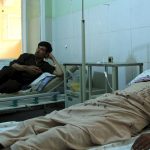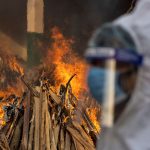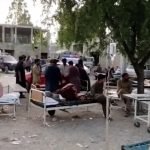New Delhi is entering a week-long lockdown to prevent the collapse of the capital’s health system amid India’s nationwide surge in coronavirus cases.
The restrictions come in on Monday night in a bid to help hospitals that are experiencing a shortage of beds, medicines and oxygen.
Live COVID updates from UK and around world
Over the weekend, patients lined up outside of medical facilities waiting to be let in, while ambulances idled outside crematoriums carrying half a dozen dead bodies each.
“People keep arriving, in an almost collapsing situation,” said Dr Suresh Kumar, who heads Lok Nayak Jai Prakash Narayan Hospital, one of New Delhi’s largest hospitals for treating COVID-19 patients.
Most desperately need oxygen, Mr Kumar said. But the city is facing shortages of oxygen and some medicine, according to Chief Minister Arvind Kejriwal, who told reporters that the new stringent measures being imposed were required to “prevent a collapse of the health system,” which had “reached its limit”.
Mr Kejriwal added that “people are getting admitted in hospitals at an unprecedented rate”, leading to a “major crisis of ICU beds”.
Delhi recorded over 25,000 new coronavirus cases and 161 deaths on Sunday, making it the worst affected city in the country. The virus positivity rate is almost 30% – a major concern for the health services.
Sky News spoke to a doctor who said: “If the situation is not brought under control soon, it will get so bad that people will die on footpaths for lack of oxygen.”
The city of 29 million people has fewer than 100 beds with ventilators, and fewer than 150 beds available for patients needing critical care.
Similar strains can be seen in other parts of the vast country.
Distressing scenes from the city of Ahmedabad, Gujarat, show dozens of ambulances on the road with COVID-19 patients attached to oxygen cylinders.
They gasp for breath as they wait to be admitted into hospitals.
Reports show hospitals have run out of beds, oxygen and in some places even medicines.
At cremation grounds, bodies are being burnt round-the-clock while graveyards are running out of space.
State governments are accused of hiding the true number of fatalities.
At a cremation ground in Lucknow, Uttar Pradesh the government erected metal sheets to keep the media and public away from taking pictures of the pyres burning inside.
India’s double mutation virus is thought to be fuelling a deadly second wave. The India variant (officially called B.1.617) is a combination of two mutations – E484Q and L452R – and was detected last year.
It has the hallmarks of being very dangerous, as the two new significant mutations in the spike protein help it infect cells and evade the immune system.
The country has registered the highest number of new virus cases anywhere in the world, with another 275,306 cases reported on Sunday. So far, 178,793 people have died.
More than 15 million people in India have had the disease, making it the second worst affected country after the US.
Technical lead officer of the World Health Organisation, Maria Van Kerkhove, said the combination of two mutations was “concerning”.
Please use Chrome browser for a more accessible video player
Last month, the Indian health ministry downplayed the mutation.
Dr VK Paul, head of the country’s COVID-19 task force, said “occurrence of mutations is a natural process”.
He added: “We should not worry about mutations. The mutations have not been detected in numbers that would sufficient to establish the rapid increase in cases in some states.”
Now 10 states have reported this new variant and more than half of the samples sequenced this month came back positive for it. In some districts of Maharashtra, the positivity rate is as high as 60%.
At least 103 cases of the India variant have been detected in Britain.
Prime Minister Boris Johnson has cancelled a visit to New Delhi next week and India has been added to the UK government’s travel “red list”, meaning travel from the country is banned for non-UK and Irish citizens.






















